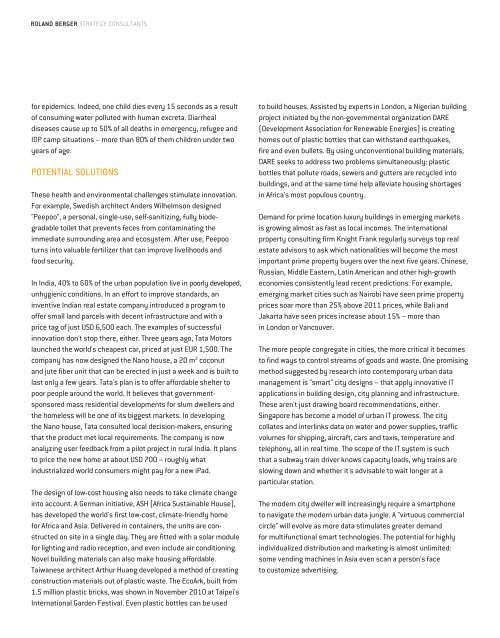How to reach emerging market consumers with new ... - Roland Berger
How to reach emerging market consumers with new ... - Roland Berger
How to reach emerging market consumers with new ... - Roland Berger
Create successful ePaper yourself
Turn your PDF publications into a flip-book with our unique Google optimized e-Paper software.
<strong>Roland</strong> <strong>Berger</strong> Strategy Consultants<br />
for epidemics. Indeed, one child dies every 15 seconds as a result<br />
of consuming water polluted <strong>with</strong> human excreta. Diarrheal<br />
diseases cause up <strong>to</strong> 50% of all deaths in emergency, refugee and<br />
IDP camp situations – more than 80% of them children under two<br />
years of age.<br />
Potential solutions<br />
These health and environmental challenges stimulate innovation.<br />
For example, Swedish architect Anders Wilhelmson designed<br />
"Peepoo", a personal, single-use, self-sanitizing, fully bio degradable<br />
<strong>to</strong>ilet that prevents feces from contaminating the<br />
immediate surrounding area and ecosystem. After use, Peepoo<br />
turns in<strong>to</strong> valuable fertilizer that can improve livelihoods and<br />
food security.<br />
In India, 40% <strong>to</strong> 60% of the urban population live in poorly developed,<br />
unhygienic conditions. In an effort <strong>to</strong> improve standards, an<br />
in ventive Indian real estate company introduced a program <strong>to</strong><br />
offer small land parcels <strong>with</strong> decent infrastructure and <strong>with</strong> a<br />
price tag of just USD 6,500 each. The examples of successful<br />
innovation don't s<strong>to</strong>p there, either. Three years ago, Tata Mo<strong>to</strong>rs<br />
launched the world's cheapest car, priced at just EUR 1,500. The<br />
company has now designed the Nano house, a 20 m 2 coconut<br />
and jute fiber unit that can be erected in just a week and is built <strong>to</strong><br />
last only a few years. Tata's plan is <strong>to</strong> offer affordable shelter <strong>to</strong><br />
poor people around the world. It believes that governmentsponsored<br />
mass residential developments for slum dwellers and<br />
the homeless will be one of its biggest <strong>market</strong>s. In developing<br />
the Nano house, Tata consulted local decision-makers, ensuring<br />
that the product met local requirements. The company is now<br />
analyzing user feedback from a pilot project in rural India. It plans<br />
<strong>to</strong> price the <strong>new</strong> home at about USD 700 – roughly what<br />
industrialized world <strong>consumers</strong> might pay for a <strong>new</strong> iPad.<br />
The design of low-cost housing also needs <strong>to</strong> take climate change<br />
in<strong>to</strong> account. A German initiative, ASH (Africa Sustainable House),<br />
has developed the world's first low-cost, climate-friendly home<br />
for Africa and Asia. Delivered in containers, the units are constructed<br />
on site in a single day. They are fitted <strong>with</strong> a solar module<br />
for lighting and radio reception, and even include air conditioning.<br />
Novel building materials can also make housing affordable.<br />
Taiwanese architect Arthur Huang developed a method of creating<br />
construction materials out of plastic waste. The EcoArk, built from<br />
1.5 million plastic bricks, was shown in November 2010 at Taipei's<br />
International Garden Festival. Even plastic bottles can be used<br />
<strong>to</strong> build houses. Assisted by experts in London, a Nigerian building<br />
project initiated by the non-governmental organization DARE<br />
(Development Association for Re<strong>new</strong>able Energies) is creating<br />
homes out of plastic bottles that can <strong>with</strong>stand earthquakes,<br />
fire and even bullets. By using unconventional building materials,<br />
DARE seeks <strong>to</strong> address two problems simultaneously: plastic<br />
bottles that pollute roads, sewers and gutters are recycled in<strong>to</strong><br />
buildings, and at the same time help alleviate housing shortages<br />
in Africa's most populous country.<br />
Demand for prime location luxury buildings in <strong>emerging</strong> <strong>market</strong>s<br />
is growing almost as fast as local incomes. The international<br />
property consulting firm Knight Frank regularly surveys <strong>to</strong>p real<br />
estate advisors <strong>to</strong> ask which nationalities will become the most<br />
important prime property buyers over the next five years. Chinese,<br />
Russian, Middle Eastern, Latin American and other high-growth<br />
economies consistently lead recent predictions. For example,<br />
<strong>emerging</strong> <strong>market</strong> cities such as Nairobi have seen prime property<br />
prices soar more than 25% above 2011 prices, while Bali and<br />
Jakarta have seen prices increase about 15% – more than<br />
in London or Vancouver.<br />
The more people congregate in cities, the more critical it becomes<br />
<strong>to</strong> find ways <strong>to</strong> control streams of goods and waste. One promising<br />
method suggested by research in<strong>to</strong> contemporary urban data<br />
management is "smart" city designs – that apply innovative IT<br />
applications in building design, city planning and infrastructure.<br />
These aren't just drawing board recommendations, either.<br />
Singapore has become a model of urban IT prowess. The city<br />
collates and interlinks data on water and power supplies, traffic<br />
volumes for shipping, aircraft, cars and taxis, temperature and<br />
telephony, all in real time. The scope of the IT system is such<br />
that a subway train driver knows capacity loads, why trains are<br />
slowing down and whether it's advisable <strong>to</strong> wait longer at a<br />
particular station.<br />
The modern city dweller will increasingly require a smartphone<br />
<strong>to</strong> navigate the modern urban data jungle. A "virtuous commercial<br />
circle" will evolve as more data stimulates greater demand<br />
for multifunctional smart technologies. The potential for highly<br />
individualized distribution and <strong>market</strong>ing is almost unlimited:<br />
some vending machines in Asia even scan a person's face<br />
<strong>to</strong> cus<strong>to</strong>mize advertising.
















